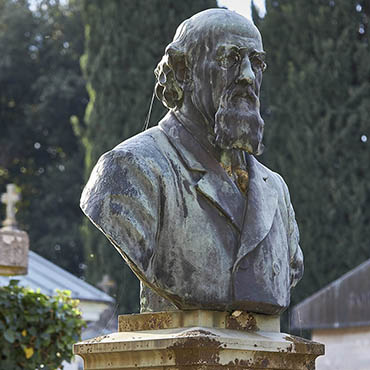Isidoro Del Lungo was born in 1841 a Montevarchi, the son of a local doctor with literary ambitions, who had a translation of the De medicina by Celsus to his name. He studied law at Siena and at Pisa and graduated in 1860. At an early age he had dabbled in poetry, but was not always successful; he got to know Giosuè Carducci, with whom he maintained a long friendship that made a deep impression on him. In the 1860s, besides starting on a significant series of educational writings of a popular nature, he began a profitable involvement with the “Archivio storico italiano” of Giovan Pietro Vieusseux and taught literature in the high schools at Faenza, Casale Monferrato, Siena, Pistoia, and finally in Florence.
He had to leave teaching when he became a member of the Accademia della Crusca and devoted himself entirely to working on the fifth edition of the Vocabolario. He felt that the study of the texts, with special attention to medieval and humanist writings, was vital to the purity of the Italian language, which at that time was taking on a special role as a unifying factor for the new-born nation. This conviction led him to work on editions of many authors, from Poliziano to Donato Velluti and to Lorenzo il Magnifico and to a critical edition of the Cronica of Dino Compagni. This last is an obvious example of that historical method that regarded the adoption of philological rigour in the reconstruction of a text and the provision of the array of documents and a huge quantity of historical and biographical information as being the main bastions against the capriciousness and shallowness of groundless historical writing. The same principles of methodology would inspire his many studies and occasional writings on Dante and his times and, especially, his commentary on the Divina Commedia published by Le Monnier in the 1920s.
The attraction of the linguistic bounty that the works of Galileo would provide for the Vocabolario of La Crusca led Del Lungo to suggest to Antonio Favaro, with whom he shared a vision of historical writing and research methods, that he should produce the national edition of Galileo, while he himself would make available to Favaro his own philological expertise, to match Favaro’s mathematical knowledge. The two became the closest of friends. The undertaking was not trivial, both because of the size of the work and because of the difficult position in which Del Lungo found himself, squeezed between the demands for rigour made by the more intransigent philologists and the wish for simplification supported by the scientists. He considered giving up, but carried on with the work only because Antonio Favaro acted as an intermediary. He became “archconsul” of La Crusca in 1914 (and later president), and he was the one who sanctioned the move of the Academy from San Marco to Palazzo Medici Riccardi. He was a member of the Società dantesca italiana, president of the Deputazione di storia patria and joined the Accademia dei Lincei.
From 1906 he was also a Senator, and in the First World War he supported Italy’s intervention and was strongly opposed to the ratification of the Treaty of Rapallo between Italy and Yugoslavia, claiming Dalmatia and Fiume for Italy. He died in Florence in 1927.
In his commemoration of Antonio Favaro in a meeting of the Lincei a few weeks after his death, Isidoro del Lungo recalled the fruits of many years of friendship and of close collaboration, but complained about the meagre print-run of the twenty volumes of the works of Galileo which by that point were unobtainable. Therefore he proposed a cheap edition, a dream that his dead friend had not been able to achieve. This initiative would have made it possible to say that “towards the supreme objective of his noble labours Antonio Favaro [would continue] even beyond the tomb his conscientious, active and skilful work”. But it came to nothing.


